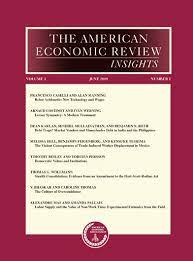Entrepreneurship, Innovation, and Productivity Growth
The research group “Entrepreneurship, Innovation, and Productivity Growth” tackles a broad set of research topics that are of relevance for our understanding of patterns of innovation and productivity growth and explores implications for workers and firms. Areas of particular focus include the decline in business dynamism, the growth in automation, entrepreneurship and innovation, and supply chains. The work is empirical in focus, it is grounded in microeconomic data research, but seeks to understand relevant macroeconomic trends.
Workpackage 1: Business Dynamism
The last decade has seen the explosion of research on business dynamism largely as a result of the development of new comprehensive firm and establishment level micro datasets. In this workpackage we exploit existing CompNet data to understand patterns of business dynamism in Europe.
In particular this subgroup seeks to explain the role of technological change and market power. The team documents the decline in young firm activity and reallocation, and estimates models that assess the causes and impacts on productivity growth (with Matthias Mertens, Sergio Inferrara, and Filippo Biondi).
Workpackage 2: Entrepreneurship
Going back to the days of Schumpeter, economists understand the important role entrepreneurs play in modern capitalist economies. This workpackage sets up a collaboration with the ZEW to develop a new data infrastructure and explore entrepreneurship in Germany broadly. Areas of research include:
a. Entrepreneurship and Firm Performance: Understanding High Growth Firms.
b. Innovative Firms and the Diffusion of Technology
c. (Im)Migration, Entrepreneurship and Regional Development
Workpackage 3: Automation
The introduction of robots and automation technologies in the workplace are fundamentally altering the balance of tasks and skills that are in demand. At the same time automation technologies increase the productivity of the workers and firms that make use of them relative to those that do not and can potentially lead to winners and losers. In this workpackage we conduct research on robot automation and its impacts on workers and firms. We focus our research both in Germany and the U.S..
The research group makes use of various administrative and survey datasets from a variety of sources and countries.
IWH Data Project: CompNet Database
The Competitiveness Research Network (CompNet) is a research network founded in 2012 to foster the debate on competitiveness issues among partner institutions and researchers. It aims at providing a robust theoretical and empirical link between micro-level drivers of competitiveness and macroeconomic performance for research and policy analysis purposes.
CompNet is funded by various European institutions, including among others: European Bank of Reconstruction and Development (EBRD); European Central Bank (ECB); European Commission (EC); European Investment Bank (EIB); European Stability Mechanism (ESM); France Stratégie; German Council of Economic Experts, Halle Institute for Economic Research (IWH); German Federal Ministry of Economic Affairs and Climate Action (BMWK); Tinbergen Institute (TI). CompNet is advised by leading researchers in the field of firm performance and has created a European micro-aggregated industry- and country-level database on indicators of firm- and country-level competitiveness and performance.
The database is unique in terms of its coverage and contents, particularly as, although being aggregated, it contains rich information on firm heterogeneity (i.e., distributional characteristics, like standard deviations and various percentiles of the firm distributions) across a large set of countries and industries in Europe. Among others, key variables included in the database are indicators of firm productivity, market power, firms’ financial situation, trade, and firm dynamics.
Research Cluster
Productivity and InstitutionsYour contact

- Department Centre for Business and Productivity Dynamics, Cbpd
Refereed Publications

Age and High-Growth Entrepreneurship
in: American Economic Review: Insights, No. 1, 2020
Abstract
Many observers, and many investors, believe that young people are especially likely to produce the most successful new firms. Integrating administrative data on firms, workers, and owners, we study start-ups systematically in the United States and find that successful entrepreneurs are middle-aged, not young. The mean age at founding for the 1-in-1,000 fastest growing new ventures is 45.0. The findings are similar when considering high-technology sectors, entrepreneurial hubs, and successful firm exits. Prior experience in the specific industry predicts much greater rates of entrepreneurial success. These findings strongly reject common hypotheses that emphasize youth as a key trait of successful entrepreneurs.

Business Dynamics Statistics of High Tech Industries
in: Journal of Economics and Management Strategy, No. 1, 2020
Abstract
Modern market economies are characterized by the reallocation of resources from less productive, less valuable activities to more productive, more valuable ones. Businesses in the High Tech sector play a particularly important role in this reallocation by introducing new products and services that impact the entire economy. In this paper we describe an extension to the Census Bureau’s Business Dynamics Statistics that tracks job creation, job destruction, startups, and exits by firm and establishment characteristics, including sector, firm age, and firm size in the High Tech sector. We preview the resulting statistics, showing the structural shifts in the High Tech sector over the past 30 years, including the surge of entry and young firm activity in the 1990s that reversed abruptly in the early‐2000s.

Measuring Job Creation, Growth, and Survival among the Universe of Start-ups in the United States Using a Combined Start-up Panel Data Set
in: ILR Review, No. 5, 2019
Abstract
The field of entrepreneurship is growing rapidly and expanding into new areas. This article presents a new compilation of administrative panel data on the universe of business start-ups in the United States, which will be useful for future research in entrepreneurship. To create the US start-up panel data set, the authors link the universe of non-employer firms to the universe of employer firms in the Longitudinal Business Database (LBD). Start-up cohorts of more than five million new businesses per year, which create roughly three million jobs, can be tracked over time. To illustrate the potential of the new start-up panel data set for future research, the authors provide descriptive statistics for a few examples of research topics using a representative start-up cohort.

Taken by Storm: Business Financing and Survival in the Aftermath of Hurricane Katrina
in: Journal of Economic Geography, No. 6, 2018
Abstract
We use Hurricane Katrina’s damage to the Mississippi coast in 2005 as a natural experiment to study business survival in the aftermath of a capital-destruction shock. We find very low survival rates for businesses that incurred physical damage, particularly for small firms and less-productive establishments. Conditional on survival, larger and more-productive businesses that rebuilt their operations hired more workers than their smaller and less-productive counterparts. Auxiliary evidence from the Survey of Business Owners suggests that the differential size effect is tied to the presence of financial constraints, pointing to a socially inefficient level of exits and to distortions of allocative efficiency in response to this negative shock. Over time, the size advantage disappeared and market mechanisms seem to prevail.

Business Dynamics of Innovating Firms: Linking U.S. Patents with Administrative Data on Workers and Firms
in: Journal of Economics and Management Strategy, No. 3, 2018
Abstract
This paper discusses the construction of a new longitudinal database tracking inventors and patent-owning firms over time. We match granted patents between 2000 and 2011 to administrative databases of firms and workers housed at the U.S. Census Bureau. We use inventor information in addition to the patent assignee firm name to improve on previous efforts linking patents to firms. The triangulated database allows us to maximize match rates and provide validation for a large fraction of matches. In this paper, we describe the construction of the database and explore basic features of the data. We find patenting firms, particularly young patenting firms, disproportionally contribute jobs to the U.S. economy. We find that patenting is a relatively rare event among small firms but that most patenting firms are nevertheless small, and that patenting is not as rare an event for the youngest firms compared to the oldest firms. Although manufacturing firms are more likely to patent than firms in other sectors, we find that most patenting firms are in the services and wholesale sectors. These new data are a product of collaboration within the U.S. Department of Commerce, between the U.S. Census Bureau and the U.S. Patent and Trademark Office.
Working Papers

Measuring the Impact of Household Innovation using Administrative Data
in: NBER Working Paper, No. 25259, 2018
Abstract
We link USPTO patent data to U.S. Census Bureau administrative records on individuals and firms. The combined dataset provides us with a directory of patenting household inventors as well as a time-series directory of self-employed businesses tied to household innovations. We describe the characteristics of household inventors by race, age, gender and U.S. origin, as well as the types of patented innovations pursued by these inventors. Business data allows us to highlight how patents shape the early life-cycle dynamics of nonemployer businesses. We find household innovators are disproportionately U.S. born, white and their age distribution has thicker tails relative to business innovators. Data shows there is a deficit of female and black inventors. Household inventors tend to work in consumer product areas compared to traditional business patents. While patented household innovations do not have the same impact of business innovations their uniqueness and impact remains surprisingly high. Back of the envelope calculations suggest patented household innovations granted between 2000 and 2011 might generate $5.0B in revenue (2000 dollars).













